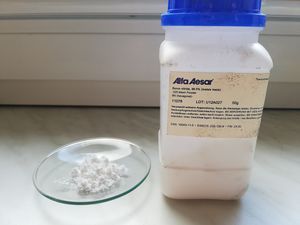Boron nitride
 Boron nitride powder
| |
| Names | |
|---|---|
| IUPAC name
Boron nitride
| |
| Preferred IUPAC name
Boron nitride | |
| Systematic IUPAC name
Boron nitride | |
| Other names
Azanylidyneborane
Borazon Elbor Elboron | |
| Properties | |
| BN | |
| Molar mass | 24.82 g/mol |
| Appearance | Colorless crystals |
| Odor | Odorless |
| Density | 2.1 g/cm3 (h-BN) 2.28 g/cm3 (amorph.) 3.45 g/cm3(c-BN) 3.49 g/cm3 (w-BN) |
| Melting point | 2,973 °C (5,383 °F; 3,246 K) (sublimes) |
| Boiling point | 2,973 °C (5,383 °F; 3,246 K) (sublimes) |
| Insoluble | |
| Solubility | Soluble in molten alkali, alkali nitrates and nitrides Insoluble in organic solvents |
| Vapor pressure | ~0 mmHg |
| Thermochemistry | |
| Std molar
entropy (S |
14.8 J·K-1·mol-1 |
| Std enthalpy of
formation (ΔfH |
-254.4 kJ/mol |
| Hazards | |
| Safety data sheet | Sigma-Aldrich (powder, ~1 μm) |
| Flash point | Non-flammable |
| Lethal dose or concentration (LD, LC): | |
| LD50 (Median dose)
|
2,000 mg/kg (rat, oral) |
| Related compounds | |
| Related compounds
|
Aluminium nitride |
| Except where otherwise noted, data are given for materials in their standard state (at 25 °C [77 °F], 100 kPa). | |
| Infobox references | |
Boron nitride is a thermally and chemically resistant refractory compound of boron and nitrogen with the chemical formula BN.
Contents
[hide]Properties
Chemical
Boron nitride is insoluble in most common acids, but is soluble in alkaline molten salts and nitrides, such as LiOH, KOH, NaOH-Na2CO3, NaNO3, lithium nitride, magnesium nitride, strontium nitride, barium nitride or Li3BN2, which are used to etch BN.
Boron nitride reacts with iodine fluoride in trichlorofluoromethane at −30 °C to produce the extremely sensitive contact explosive, nitrogen triiodide.
Physical
Boron nitride exists in multiple forms that differ in the arrangement of the boron and nitrogen atoms, giving rise to varying bulk properties of the material:
- Amorphous:The amorphous form of boron nitride (a-BN) is non-crystalline, lacking any long-distance regularity in the arrangement of its atoms. It is analogous to amorphous carbon.
- Hexagonal: corresponding to graphite is the most stable and soft among BN polymorphs; therefore used as a lubricant and an additive to cosmetic products.
- Cubic (sphalerite structure): variety analogous to diamond is called c-BN; it is softer than diamond, but its thermal and chemical stability is superior.
- Wurtzite: rarely encountered, is similar to lonsdaleite but slightly softer than the cubic form.
Bulk boron nitride is extremely hard, with the hardness of c-BN being slightly smaller and w-BN even higher than that of diamond. Polycrystalline c-BN with grain sizes on the order of 10 nm is also reported to have Vickers hardness comparable or higher than diamond. Because of much better stability to heat and transition metals, c-BN surpasses diamond in mechanical applications, such as machining steel. The thermal conductivity of BN is among the highest of all electric insulators.
Availability
Boron nitride is sold by chemical suppliers, usually as powder or some other form.
Boron nitride has been identified as the extremely rare mineral qingsongite, which so far has only been found in some minute inclusions within chromite deposits in the Luobusa ophiolite, in Tibet.
Preparation
Hexagonal boron nitride is obtained by the reacting boron trioxide or boric acid with ammonia or urea in a nitrogen atmosphere.
h-BN can be obtained from amorphous BN at high temperatures.
Synthesis of c-BN uses same methods as that of diamond: Cubic boron nitride is produced by treating hexagonal boron nitride at high pressure and temperature, much as synthetic diamond is produced from graphite. Direct conversion of hexagonal boron nitride to the cubic form has been observed at pressures between 5 and 18 GPa and temperatures between 1730 and 3230 °C, that is similar parameters as for direct graphite-diamond conversion.
Wurtzite BN can be obtained via static high-pressure or dynamic shock methods.
Projects
- Compound collecting
- Abrasive
- Crucible
- Nanoparticles
Handling
Safety
Boron nitride is reported to show weak fibrogenic activity, and to cause pneumoconiosis when inhaled in particulate form.
Storage
In closed bottles or boxes.
Disposal
No special disposal is required. It can be dumped in trash.
Gallery
